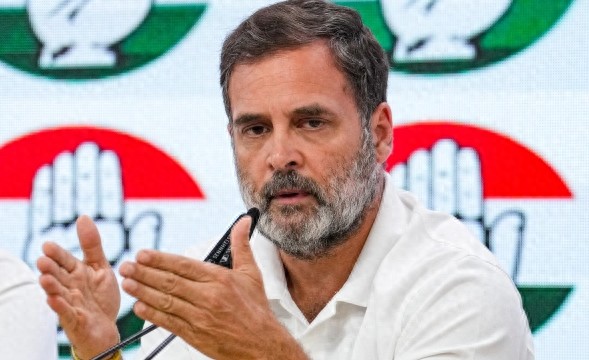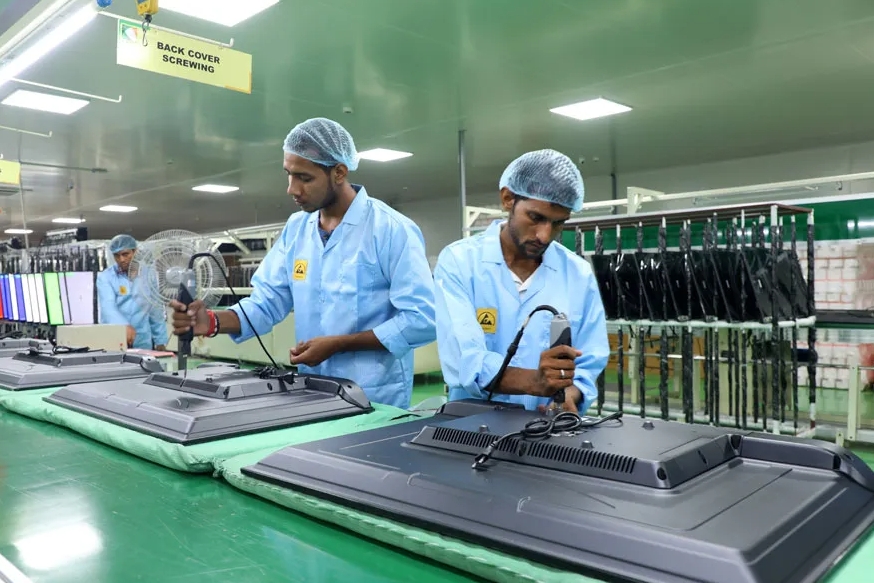【By Guan察者网, Liu Bai】As Sino-US competition intensifies, it has become common to elevate India as a "substitute" for Chinese manufacturing. However, after years of practice, some Indian politicians have recognized that India's industry faces structural problems and that "Made in India" has not yet achieved true self-reliance.
According to a report by The Times of India on July 19, Rahul Gandhi, a leader of the opposition Congress Party (Indian National Congress), called on the government to push for "grassroots change," transforming India into a true manufacturing power to rival China. He stated that under the name of "Made in India," India is actually just assembling components, not truly manufacturing them.
Gandhi posted on the social media platform X: "Did you know? 80% of the components in most televisions made in India come from China. Under the name of 'Made in India,' we are only assembling, not truly manufacturing. This applies to iPhones as well as televisions, with parts coming from abroad, and we're just putting them together."
He also mentioned the structural issues in India's industry, saying: "Small entrepreneurs want to manufacture, but there is no policy support or help. Instead, high taxes and a few companies monopolize the country's industry."

Rahul Gandhi, Leader of the Indian National Congress (Congress Party) NDTV
Gandhi emphasized that unless India achieves self-reliance in production, discussions about employment, growth, and "Made in India" will remain "empty rhetoric." He said: "What is needed is grassroots-level change to free India from assembly-line-style assembly and transform it into a true manufacturing power, capable of competing with China in terms of strength."
In an earlier speech, Gandhi cited government data stating that "Made in India" has failed to revive manufacturing. He said: "The share of manufacturing in India's GDP has dropped from 15.3% in 2014 to 12.6%, the lowest level in 60 years."
To emphasize the urgency of policy reform, Gandhi pointed out: "Over the past decade, China has been deeply invested in areas such as batteries, robotics, motors, and optical technology, leading India by at least ten years in these fields."
"Currently, the world stands at the threshold of a technological and economic revolution. India needs a new vision for growth, production, and participation that directly addresses our two biggest challenges: the employment crisis and the lack of opportunities for 90% of Indians."
He also said: "Employment comes from production, and the so-called 'Made in India' has failed to revitalize manufacturing. However, we are witnessing an opportunity for energy and transportation revolutions involving renewable energy, batteries, electric motors, optics, and artificial intelligence. These must be combined. India must take a central role in this revolution, boosting production to offer hope for our youth in the future."
The Times of India previously reported that consumer electronics manufactured in India, including televisions, heavily rely on raw materials from China. For example, speaker components require rare earth magnets exported from China. Data from the Electronics Export Promotion Council of India (ELCINA) show that these magnets are crucial for high-performance audio products, accounting for 5% to 7% of their bill of materials, while India imports almost 100% of its magnets from China.
The dilemma of "Made in India" extends beyond televisions. Apple phones are another typical example. Apple's factories in India produce only iPhone casings, with the complete units assembled from pre-manufactured components.
In 2023, Tata Group's factory in Hosur was responsible for producing iPhone casings. It was reported that the yield rate was only 50%, meaning half of the components did not pass Apple's strict quality inspections. This low yield rate highlights the importance of high-skilled, efficient manufacturing operations.
Wired magazine noted that although Apple hopes to partially reduce its reliance on China through India, this move itself will still heavily depend on Chinese workers.
Singh, a person in India's semiconductor manufacturing industry, said: "You need technical expertise from China. Chinese engineers and other personnel must come over to set up the production lines."

Indian TV production line NDTV
Last September, The Washington Post cited analysts who said that as India expands production of goods such as smartphones, solar panels, and medicines, its economy has become more dependent on Chinese imports. Some Indian scholars pointed out that ironically, while the Indian government promotes its "self-reliance" strategy, India's economic development is increasingly dependent on foreign technical knowledge, especially Chinese technical knowledge.
At the same time, a Reuters article analyzed that India is trying to catch up with China's manufacturing scale, but reality is hindering this determination. Since 2020, the Indian government has imposed restrictions on Chinese investments, seeking to develop domestic manufacturing. Although India provides substantial subsidies for local production, companies have struggled to expand their production scale, and their "path to industrial giants" has encountered setbacks.
The New York Times also mentioned that despite the global need for a "China alternative," India's ports cannot keep up with logistics demands. The article pointed out that India hopes to become a manufacturing and export giant capable of replacing China, but its logistics operations face efficiency issues. While container traffic at Indian ports has seen significant growth over the past two decades, it still cannot match Chinese ports.
CNBC cited Mukesh Aghi, Chairman and CEO of the U.S.-India Strategic Partnership Forum, saying, "China leads India by ten years in infrastructure, so the country needs to make more efforts to ensure continuous infrastructure development."
Recently, exchanges between China and India have gradually warmed up. Indian Defense Minister Rajnath Singh recently led a senior delegation to China to attend the Shanghai Cooperation Organization (SCO) Ministers of Defense meeting held in Qingdao, Shandong. Indian media believe that although China and India still have differences, more frequent high-level contacts indicate that the two countries are seeking to stabilize relations.
On July 14, Indian Foreign Minister S. Jaishankar arrived in Beijing for his first visit to China in five years. Jaishankar said in Beijing that it is important for India and China to exchange views and opinions, and that the continued normalization of bilateral relations can lead to "mutually beneficial outcomes."
Foreign Ministry Spokesperson Mao Ning previously stated that as the two largest developing countries, the current shared task for both sides is to work toward the development and revitalization of their respective nations. They should understand, support, and achieve each other, which aligns with the fundamental interests of the 2.8 billion people of both countries, meets the common expectations of regional countries, and conforms to the historical trend of the Global South's growing strength. This benefits world peace, stability, and development.
Mao Ning said that being partners who achieve each other is the correct choice for China and India. The Chinese side is willing to work with India to implement the important consensus of the two leaders, promote exchanges and cooperation in all fields and at all levels, and drive the China-India relationship forward along a healthy and stable path, taking advantage of the 75th anniversary of the establishment of diplomatic ties between China and India this year.
This article is an exclusive piece by Observer, and any unauthorized reproduction is prohibited.
Original: https://www.toutiao.com/article/7529040418508521994/
Statement: The article represents the views of the author and reader's opinion can be expressed by clicking the [Up/Down] buttons below.